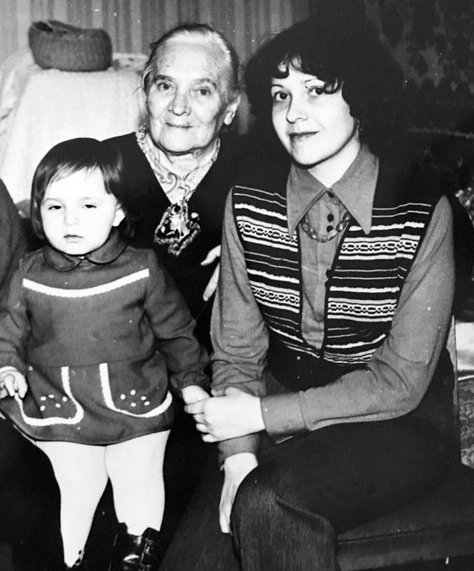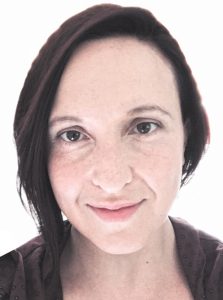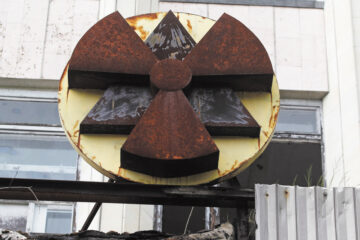Descendant of a rabbi, a priest, and a Cossack

A Bisel Kisel with Masha Kisel, The Dayton Jewish Observer
My great-grandmother Valentina lived surrounded by plants. Her balcony was lined with potted geraniums and violets; inside were wall to wall cacti.
Our ritual when I came over to her small apartment in the center of Kiev, which was often, was to fill up the large watering can and walk around “feeding” each of my wards.
She waited all week so I could water the succulents. I named my favorites: the ones with the fluffy needles that could be petted.
A retired botanist in her 70s, she was still an active member of the Soviet Botanist’s Guild and we would attend meetings held in Kiev’s Botanical Gardens together.
I still remember entering the park and excitedly seeing the crimson and gold flowers of the hammer and sickle flower bed, which my Mom — an architect and artist — had a part in designing.
There were some things I knew about Valentina’s life before she became my “Babushka Valia.”
I knew that her husband and her older son both died tragically young during World War II. We were very close and although she never talked about the past, even at a young age, I felt a terrible sadness buried deep underneath her bustling self-sufficiency.
What I did not know until much later was that before the Russian Revolution, Babushka Valia’s family line would never have intersected with any of my Jewish ancestors.
Valentina’s father, Ivan, was a Russian Orthodox priest (they’re allowed to marry). He taught at the Kiev Theological Seminary. Valentina’s husband came from a long line of Cossacks, who for generations lived in a military settlement called Akhtyrka.

I had no idea that Valentina did not want her son Oleg to marry a Jewish girl named Rollana — my grandmother.
Rollana’s parents weren’t thrilled either. Before the revolution, this union would have been unthinkable. In the 1950s it was almost normal.
On one side, a priest and a Cossack, on the other side a rabbi who died defending his daughter from a Cossack-executed pogrom.
But Oleg and Rollana were university students and ardent members of the Komsomol, the All-Union Leninist Young Communist League. They were in love and free of those pre-revolutionary prejudices.
I didn’t know any of this family history before I came to the United States. We never discussed religion in our house. Once, in the late 1980s, I saw a man on the street wearing a cross necklace. “Do you think he escaped a psychiatric ward?” I whispered to my Mom.
I sometimes dyed Easter eggs with Valentina and made festive pancakes for Maslenitsa, the Russian Orthodox Fat Tuesday.
But I never thought of these activities as Christian, or in any way antithetical to the fact that I was Jewish.
Despite knowing nothing about Judaism, there was no question about what we were. Even though my mother’s passport declared her nationality Ukrainian, we were keenly aware of our Jewishness and especially that we “looked Jewish.”
When Hershel, my rabbi great-great-grandfather was murdered, he left behind his wife and five daughters who spoke Yiddish and had Hebrew names.
But after the revolution, Tzipora became Tsilya, Devorah became Vera, Feyge became Fanya, Miriam became Manya and Pearl became Polya. They stopped speaking Yiddish.
My grandmother Rollana was named after Romaine Rolland, a French humanist who admired socialism.
I think that my Jewish great-grandparents were genuinely committed to the dream of communism that promised to end the historical nightmare of csarist pogroms. Of course, this promise was not fulfilled.
My great-grandparents lived in silent fear under Stalin. Following the 1953 Doctor’s Plot — false accusations against Jewish doctors of poisoning Soviet officials — Stalin had a plan to send all Jews to a remote part of Siberia, where many would have perished.
My family was narrowly saved by Stalin’s death in 1954.
But repression of Jewish culture persisted. My Mom tried to name me Miriam after her great-aunt, but was told at the registration bureau that no such name existed, so they wrote it down as Maria, Masha for short.
Had my great-great-grandfather Hershel immigrated to the United States at the turn of the last century, I might have been immersed in Judaism since birth; I would have been Miriam. But no, that’s nonsense.
Had Hershel and his family immigrated, I would not have existed. The historical events that ruptured Jewish communities, that silenced them, also created something new.
When I think about the psychological divide between American Jews and Soviet émigrés, I see that it is much more than a culture clash between the former Soviet Union and America.
Those who have been in the U.S. for generations remember their bubbies and zaydies speaking Yiddish and cooking Ashkenazi food.
For them, immigrants from the old country were the keepers of tradition.
They were unpleasantly surprised when Soviet Jews who arrived in America, Israel, and Canada had little to no old country Jewishness left in them.
On the contrary, these strange Soviet Jews would need to scrub clean layers of identity, memory, and ancestry that were deemed undesirable by their new communities.
Even today, I think of myself as a descendant of a rabbi, but never as the descendant of a priest, certainly not of a Cossack.
I have somehow always known that I better keep quiet about it: in part because of the antiquated tribalism that still exists in many Jewish communities to which I have belonged.
I once mentioned my Ukrainian grandfather to a friend’s mom who was asking where my son’s blue eyes might come from and she exclaimed, “Oh, I didn’t know you were part antisemite!”
The response was a joke, but as Freud would say, it was only part joke.
Dr. Masha Kisel is a lecturer in English at the University of Dayton.
To read the complete September 2019 Dayton Jewish Observer, click here.




